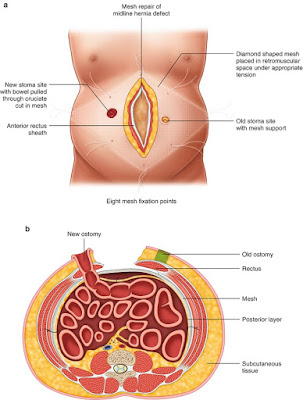What is Colostomy?
A colostomy is a hole in the lower left side of
the patient's abdomen, created in a small part of the colon (large intestine).
It has been fabricated in the result of an infection in the colon, colon
cancer, blockage in the colon, injury in the colon, injury in the bowel,
ulcerative disease, inflammation in the bowel, or any other serious bowel
disease.
After the diagnosis of a specific disease related
to the colon, large intestine, or bowel, doctors suggest some medicines. If the
illness stays remain and bothers the anal system of the patient, then there is
the need for colostomy. Moreover, in the case of cancer and radiation treatment
of the colon, a person must need the colostomy opening for the proper
functioning of the bowel and large intestine.
Therefore, surgeons design a round pit in the
lower left side of the belly wall, it excretes stool through this stoma or
opening. In the colostomy operation, the anus of the patient does not discharge
the feces. A section of the colon (large intestine) takes to the stoma, and
after this artificial practice, an ostomate releases the solid waste through
the stoma. The stool or feces collects into a container or bag, called an
ostomy pouch or stoma pouch. There is a complete pouching system that holds the
waste, protects the opening, and provide comfortability to the patient. The
colostomy can be for a few months, until the recovery of the disease, or for
the entire life.
Types of Colostomy
There are different types of colostomies relying
on the disease and the treatment of specific parts of the large intestine and
bowel. Well, the two common names are temporary colostomy and Permanent
colostomy.
Temporary Colostomy
This is a reversible process. Temporary colostomy
means that your colon will attach to the anus, after the healing of the
infection or disease. Thus, the stoma will get closed after the large intestine
or a section of the bowel will bring back.
Permanent Colostomy
It is the building of stoma for the rest of the
life of the patient. When there is a chronic bowel disease, radiation
treatment, or colon cancer, then an infected section of the large intestine or
bowel removed permanently. Then, for the rest of the life, an ostomate
discharges feces through the stoma.
Transverse Colostomy
Transverse colostomy occurs due to
Diverticulitis, obstruction, birth defect, blockage, injury, or inflammatory
bowel disease. In this surgery, an upper portion or lower portion of the colon
was removed due to the mentioned diseases. It appears on the right side or in
the middle of the abdominal wall. The purpose of the removal of the transverse
colon is to discharge stool before reaching to the descending colon. This could
be permanent and temporary, depending on the removal portion.
Ascending Colostomy
It also fashions on the right side of the belly
button. In the ascending colostomy, a small segment of the colon remains
active, and the infected part removes from the large intestine. Moreover, it
releases a liquid form of stool; therefore, in such defects, usually doctors
suggest ileostomy.
When a portion of the descending colon removes
due to the injury or obstruction, and stoma appears on the left side, it is
descending colostomy. It discharges a firm formation of feces.
Sigmoid Colostomy
A section of the large intestine is known as
sigmoid. Thus, when an incision and removal required in the sigmoid colon,
called a sigmoid colostomy.
Pouching System for Colostomies
The appropriate pouching system for colostomy
patients is discardable pouches and bags. The drainable needs frequent emptying
and cleaning, but a colostomy patient discharges a firm and solid form of
stool; therefore, there is no need to drain a bag again and again. A colostomy
knows the movement pf bowel; however, after the discharge of waste, a patient
can go to the loo and empty the bag. Moreover, a colostomy person should wear a
new pouching system including adhesive, stoma bag, skin barrier, and flanges
after every two days. In the case of transverse or loop colostomies, you can
wear a drainable pouching system.










